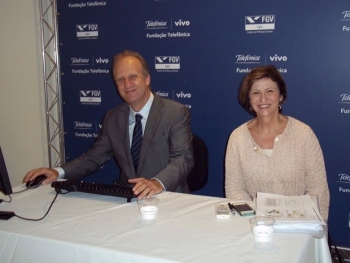The Center of Political Sciences (CPS) announced on July 31st, its new study "The Beginning, the End and the Digital Media Coverage, Capacity and Convergence," conducted in partnership with the Fundação Telefônica. Using newly available micro data from the Census 2010 and digital data from over 150 countries, the research continues the studies on digital inclusion and mapping of the digital technology access started with the "Map of Digital Inclusion," released in May this year.
The study follows the dissemination and use of various Information and Communication Technologies (TICs) in society, both in a macro perspective - by country - as well as a regional perspective, mapping Brazilian states, cities and neighborhoods, from the creation of a synthetic indicator that integrates Telephony, Internet and Mobile phones, the ITIC. "Brazil is in the midst of the digital world," said the chief economist at CPS, Marcelo Neri, when comparing the country's index value, of 51.25%, with the world average of 49.1%. The survey shows that Sweden is the most inclusive in the world, while the Central African Republic is the one that have the least access to such technologies. The survey also projects the use of digital technologies in different segments of society such as women and youth, linking them with the Index of Happiness. "It's not possible to tell if there is an exact determination, but we noted that digital inclusion, happiness and income are highly correlated," said Neri, who also noted a trend in Brazil of not fitting into a kind of international "standard". "The happiness of the Brazilian is not as determined by income and access to digital technologies as in other countries of the world," he says. In the women's segment, the rule seems to apply. "The cell phone exerts more influence on the happiness of women than in men".
The survey shows that the most inclusive city of Brazil is São Caetano do Sul in São Paulo, and that two of the most inclusive capitals are located in the South: Florianópolis and Curitiba. In Rio de Janeiro, the community Complexo do Alemão is the place with the lowest inclusion rate, followed by Jacarezinho and Maré. Despite displaying the lowest levels of inclusion in the city, these communities are above the national average (according to the 2010 Census, by the national average data of Gallup, Complexo do Alemão is a bit below it) and the world. The mobile phones are ahead in the city of Palmas, Tocantins state, a city that also has the youngest population of Brazil.
Today the access to information technology is one of the eight indicators that comprise the UN Millennium Development Goals, which indicate global commitments that have to be assumed by the year 2015. FGV is part of the international committee that determines the new goals and it will host the final meeting on the Post-2015 Targets in September.
The research is already available at www.fgv.br/cps/vivo
*In the photo, Neri and Leila Lorea, representative of Fundação Telefônica





